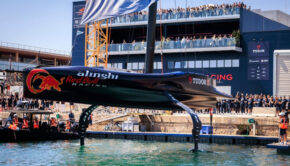What will the next Cup look like?
Published on December 22nd, 2020
What if the New York YC was successful in its challenge for the 36th America’s Cup? It’s not too early for Gary Jobson of Sailing World to start pondering what the next Cup could be should it return to U.S. shores.
It might seem bold to strategize internally about a future sporting competition that has yet to be won, but the America’s Cup is such a complex event that it requires early planning. All four teams competing in Auckland for the 36th America’s Cup believe they can win, and they are surely thinking about what’s best for this venerable regatta should they get their hands on the Auld Mug.
The biggest reward (or burden, some might say) for successfully challenging is the right to host it on home waters. This is one of the key incentives dating back to the first defense in 1870, and it stands true today. Just ask New Zealanders, who have poured millions into Auckland’s waterfront development, or Larry Ellison, who transformed once-derelict piers on San Francisco Bay into a pop-up international sporting stage.
The same is true of America’s Cup yachts. There has been a dramatic acceleration of new designs since 1988, and while there is little that’s ever predictable about the Cup, one thing is for certain for the next defense: The boat of choice will evolve again.
Flag officers of the New York YC, alongside principles of the American Magic challenge, have been quietly discussing what the next America’s Cup might look like should they prevail in Auckland. Returning the Cup to its deeper roots is a core component of these ongoing discussions. The New York YC, in concert with a long list of challengers between 1870 and 1983, changed the parameters of the racing boats many times.
The International 12 Metre Class proved to be an enduring yacht that was used for 10 Cup cycles. One reason for the 12 Metre’s longevity is that most sailors relate to the elegant sloops. Tradition-minded sailors, and the general public, either don’t embrace or comprehend the 75-foot foiling monohulls that will race off Auckland.
The questions being asked today, therefore, are focused on the type of boat: What format would attract a larger number of challengers and defenders? What design innovations will trickle down to the rest of the sport? How can the gargantuan costs be reduced? And what kind of event will attract a large viewing audience? – Full story









 We’ll keep your information safe.
We’ll keep your information safe.